| |
|
Photographs of Wildlife Poop in Attics
Click any of the below photographs for a larger, high-resolution image:
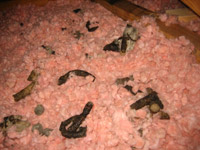
Raccoon Poop In Attic |
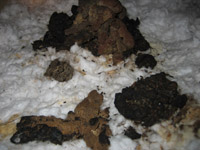
Raccoon Feces In Attic |
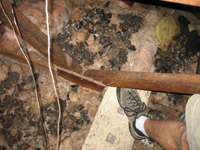
Raccoon Poop - Big Mess! |
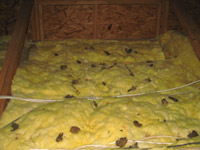
Opossum Poop In Attic |
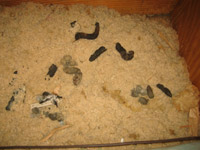
Opossum Waste In Attic |
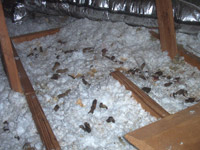
Opossum Feces In Attic |
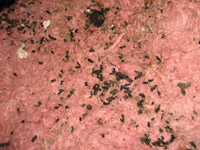
Rat Poop in Attic Insulation |
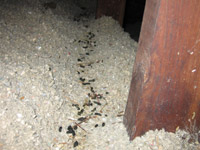
Rat Poop Trail in Attic |
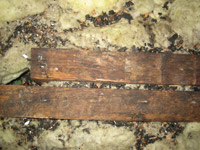
Rat Feces In Attic |
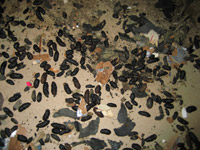
Squirrel Poop in Ceiling |
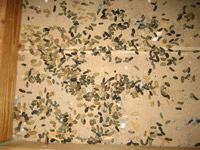
Lots of Squirrel Poop |
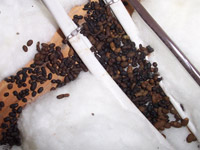
Flying Squirrel Poop Area |
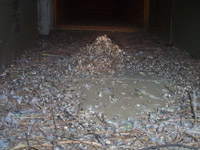
Pigeon Poop in Air Duct |
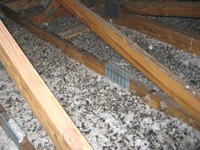
Pigeon Droppings in Attic |
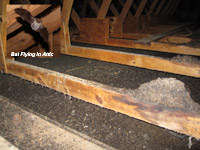
Bat Poop in Attic |
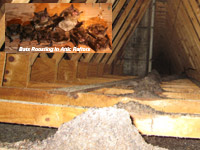
Bat Guano Buildup in Attic |
Wild animals leave a lot of poop in your attic when they live there. This is not only smelly (even though you might not smell it at all up there), but it is unsanitary, and a potential biohazard. It attracts insects and other vermin, and may attract new wildlife to
try to break into and live in your attic. Even if you can't smell it, other wild critters can!
Learn more about specific animal waste, including information on animal-specific diseases and cleanup advice:
Raccoon Feces - Opossum Feces - Squirrel Feces - Rat Feces
What eats away feces? Can they be dissolved by fogging/spraying?
Good bacteria eat away feces. If you’re looking for a caustic agent to do the trick, you’re out of luck. When it comes to nuisance animal feces and the removal of,
you need to be very careful how you go about cleaning up the mess. Most wild animal droppings carry some risk of zoonotic disease. Zoonotic disease means the illness can be
transmitted from the animal to the person cleaning the area. If you’re trying to melt away the feces from a nuisance animal, that is not in your best interest. The world is full
of strong chemicals that can dissolve feces into mush but that doesn’t mean you should use those agents. If you pour a caustic agent over the mounds of opossum poop in your attic,
you run the risk of damaging your home’s infrastructure as well as aerosolizing any dangerous particles within the fecal matter. More likely than not, the feces will be reduced to
a slush that will then need to be scraped off of surfaces rather than easily pushing into a bag and discarded. When it comes to cleaning up after the attentions of a nuisance animal,
tedious, thorough cleaning by hand is the best reliable method. If you do not want to undertake this task yourself, don’t turn to a potent chemical agent; turn to a professional who will
have the equipment and experience to take care of the situation. He will remove the feces, remove the soiled insulation, and use a special enzyme and bacteria-based cleaner to
eat away at the feces.
Learn proper methods for Attic Decontamination and Cleanup.
If you need help, click my Nationwide Directory of Wildlife Professionals serving almost every
USA town, in all 50 states.
Here is an email I received from a concerned reader about animal feces in the attic:
Just recently discovered at least two batches of Raccoon feces in my attic. The same day I investigated noise and searched part of the attic with a flashlight and came face to face with one adult raccoon. I left the attic and didn't touch any feces. I also contracted a reputable animal control which popped up from your website. A wildlife control company in my city checked our my attic and found my large exhaust vent screen to be the area of entering the attic. A trap was set on the ground in the bushes in front of my house by a large spruce tree which he thinks it is using to climb up to the roof. This is night number two since the trap was set and we heard activity in the attic today so we know the
raccoon is still in the attic. In speaking with animal control as well as the insurance company I am left very confused with the following.
Not knowing for sure if the attic is contaminated with Parasitic Roundworms (Baylisascaris Procyonis) I am concerned with whether or not I can salvage numerous plastic bins containing summer clothing, outgrown childrens clothing, books, toys, excellent condition strollers and car seats (in large black plastic bags) and other miscellaneous items I would hate to have to just dispose of.
Once we are sure the Raccoon is gone (trapped in a Live-Trap) the insurance adjuster stated they can recommend a reputable company to seal off all the vents and somehow I guess fumigate the attic. They would then remove and replace all my attic insulation after removing all items from the attic via the ceiling hatch in my walk in closet of my master bedroom and out one of the bedroom windows onto the front lawn of the house.
I would appreciate and value your professional opinion on what if anything we can do to salvage items from the attic.
Sincerely, Larry and Pat of Canton Michigan.
My Response: In my opinion, I do not consider raccoon feces a very common or likely health threat,
unless they are directly handled. I myself have been in hundreds of attics filled with raccoon poop. Nothing bad has ever happened
to me. To clean raccoon waste, if you want to be super careful
when touching potential hazards such as feces and urine, you should wear a HEPA filter mask, since raccoon poop has a small chance that it'll contain roundworm spores. And wear latex gloves. Remove any waste by hand and bag it, and any soiled insulation. I spray the attic, especially the soiled areas with Bac-Azap which costs $8.95, and you can buy it from this site, or many other online retailers. I would not throw away anything in the attic, even if it had raccoon poop right on it. If it did, I'd wipe it down with bacteria killing disinfectant, while wearing latex gloves and a simple filter mask. Even that is being extra super-duper cautious.
| |
|